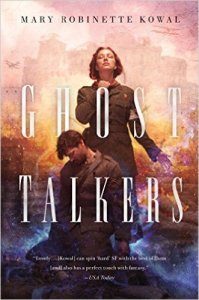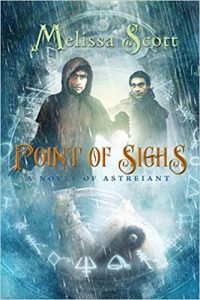Ian Mond Reviews Dead Astronauts by Jeff VanderMeer
 Dead Astronauts, Jeff VanderMeer (MCD 978-0374-27680-5, $27.00, 352pp, hc) December 2019.
Dead Astronauts, Jeff VanderMeer (MCD 978-0374-27680-5, $27.00, 352pp, hc) December 2019.
Whatever success the British and American New Wave had in broadening our definition of science fiction and fantasy, the Modernist techniques the movement embodied never caught on. There are strong, market-driven reasons why this is the case, why, if you want to a read a genre novel that deliberately eschews a linear, conventional structure you need to look outside the field (for example, Lanny by Max Porter and The Archive of Alternate Endings by Lindsey Drager), or at translated works (Dark Constellations by Pola Oloixarc and Sisyphean by Dempow Torishima). There are exceptions, authors like Nina Allan, M. John Harrison, and Adam Roberts who actively push against the boundaries of storytelling. And there’s Jeff VanderMeer. Going as far as back his debut, Dradin, In Love and, more recently, his extraordinary (and hugely successful) Southern Reach Trilogy, VanderMeer has built a career on narratives that explore the limits of fiction, both in terms of language and form. His latest novel, Dead Astronauts, set in the same Universe as Borne (2017), takes that sense of invention and playfulness to the extreme, giving us a modern and post-modern tour-de-force unlike any mainstream science fiction novel written over the last two decades.
If you’ve read Borne (and I suggest you do, not just to provide context, but also because it features a three-story-high flying bear named Mord) you might recall that Rachel, the novel’s protagonist, comes upon three half-buried bodies on one of her scavenger hunts.
Three dead astronauts had fallen to Earth and been planted like tulips, buried to their rib cages, then flopped over in their suits, faceplates cracked open and curled into the dirt. Lichen or mold spilled from those helmets. Bones, too.
Rachel soon realises they are not astronauts but rather skeletons dressed in contamination suits that have been bleached white. The name sticks, though, and the dead astronauts feature a handful of times, most gruesomely as objet d’art hanging off the wall of Borne’s apartment. Dead Astronauts, given its title, promises to reveal the identity of the astronauts and expand our understanding of the Borne Universe. From the outset it’s clear that VanderMeer isn’t interested in a straightforward join-the-dots prequel (or sequel). In a biblically flavoured opening – a flavour that carries through the novel – a blue fox foreshadows to its fox-brethren the coming of the Company. “They shall have no face. They shall have nobody at which to strike… [they] shall issue forth… beasts and monsters and creatures that shift their form in ways that you cannot imagine.” The next (and longest) section of the book introduces us to Grayson, Chen, and Moss. Grayson is, in fact, an astronaut who has lost her crew “from all the ways space can murder you” and has returned to an Earth radically twisted out of shape by the Company. Chen and Moss are products of the Company and its genetic experiments. Chen can see “bits and pieces of the future, ‘but only in equations,”‘ while Moss can “open all kinds of doors” between realities. The three “astronauts” travel from City to City, from Earth to Earth, from timeline to timeline, hoping to destroy the Company and save what’s left of the future.
Theirs is not the only story. In an ever-increasing series of strange and dizzying shifts in perspective, we experience the rise and fall of the Company through the impressionistic dreams and memories of the Leviathan and the Dark Bird. We are also privy to the fractured, deranged memories of Charlie X – who appears in both Borne and the Borne novella The Strange Bird and is notable for the mice living in his throat – stumbling through a wasteland of monsters partly of his own creation, reliving the abuse he suffered at the hands of his father. We witness the Company’s invasion of one of many possible Earths, from the point of view of a homeless woman named Sara who, like Charlie X, has endured parental abuse. Drawing these multiple and varied viewpoints together is the enigmatic, inscrutable blue fox, whose presence haunts both Borne and The Strange Bird. It’s the blue fox that advises Borne to decorate its apartment with dead astronauts (to provide the room with some pizazz). It’s the blue fox, itself hanging as a trophy in an underground lab, who helps the Strange Bird fulfill its purpose. It’s the blue fox who understands that, for all their efforts, Grayson, Chen, and Moss will ultimately fail. The blue fox’s story is one of entrapment and pain (“They brought me back. They killed me. They brought me back. They killed me.”) and also one of survival (“You couldn’t kill us all”). More importantly – and in line with VanderMeer’s passion for ecology – it is a condemnation of how we have slowly but surely eradicated the flora and fauna of our planet (“What a nothing you made out of the world you were given”). The prose is rhapsodic and intense, including an extraordinary elegy – that reminded me, sans the eroticism, of Molly Bloom’s soliloquy in Ulysses – describing the many and horrible ways the fox and its kind have been slaughtered by humans.
Those expecting a novel with a similar feel and structure to Borne and The Strange Bird may initially find Dead Astronauts confounding. If they persevere – and I highly recommend they do – they will become immersed in a world that has the bones of those previous books but is so much more. Dead Astronauts is a story of hatred and revenge, of redemption and love, of environmental disaster and rebirth. It is unabashedly experimental, threaded with a lyricism and poetry – especially when it comes to describing the natural world – that is achingly beautiful, and, most pleasing of all is a work of fiction that harks back to the New Wave, igniting a beacon for other genre writers to follow.
Ian Mond loves to talk about books. For eight years he co-hosted a book podcast, The Writer and the Critic, with Kirstyn McDermott. Recently he has revived his blog, The Hysterical Hamster, and is again posting mostly vulgar reviews on an eclectic range of literary and genre novels. You can also follow Ian on Twitter (@Mondyboy) or contact him at mondyboy74@gmail.com.
This review and more like it in the December 2019 issue of Locus.
 While you are here, please take a moment to support Locus with a one-time or recurring donation. We rely on reader donations to keep the magazine and site going, and would like to keep the site paywall free, but WE NEED YOUR FINANCIAL SUPPORT to continue quality coverage of the science fiction and fantasy field.
While you are here, please take a moment to support Locus with a one-time or recurring donation. We rely on reader donations to keep the magazine and site going, and would like to keep the site paywall free, but WE NEED YOUR FINANCIAL SUPPORT to continue quality coverage of the science fiction and fantasy field.







